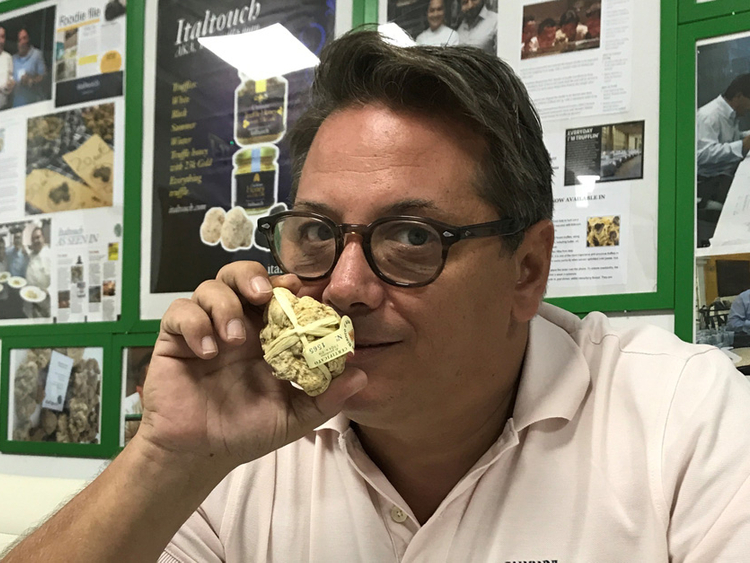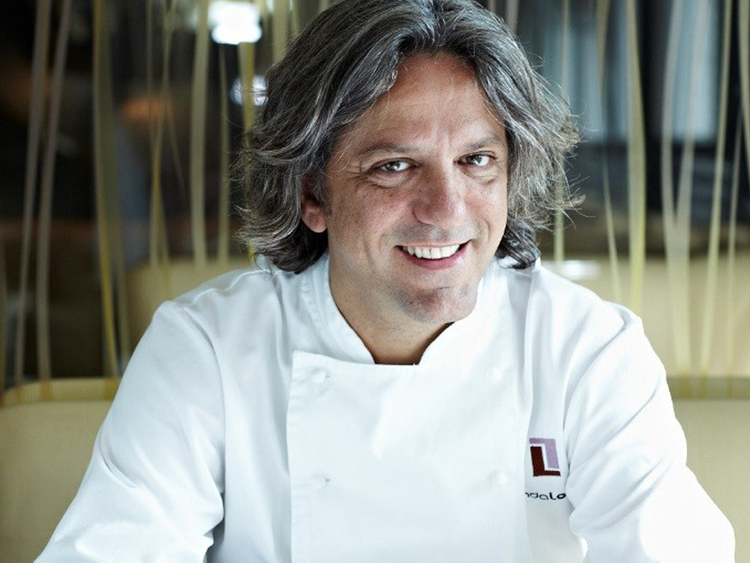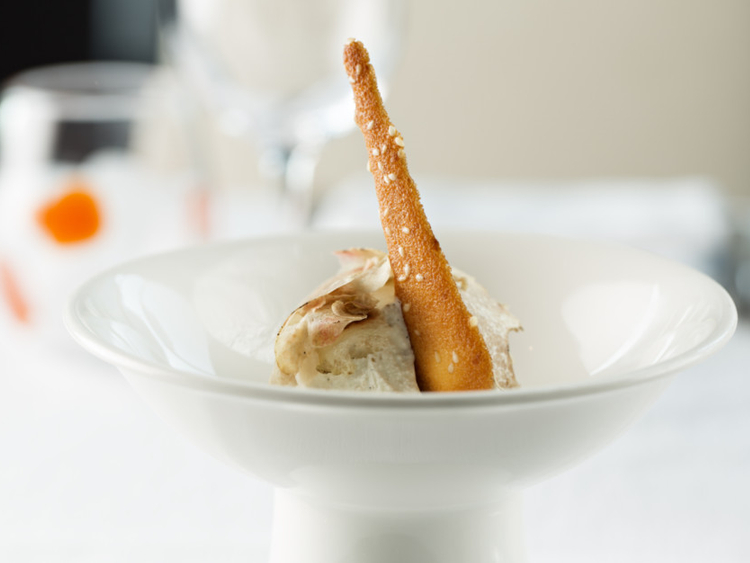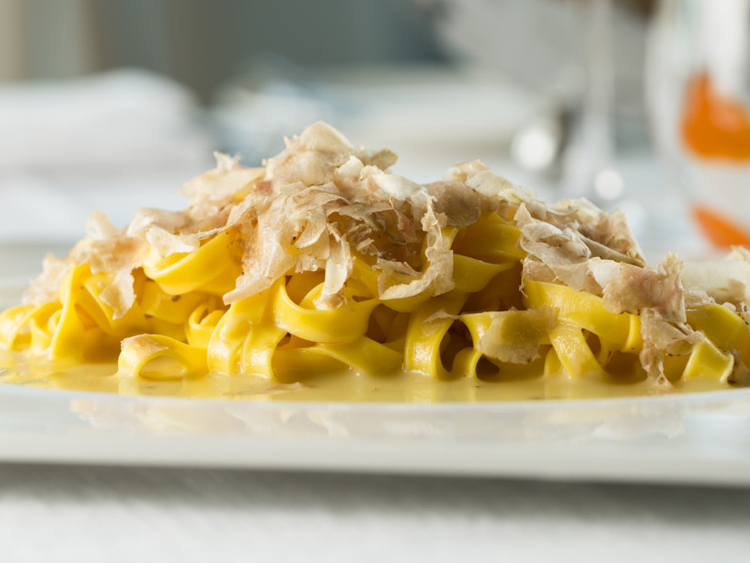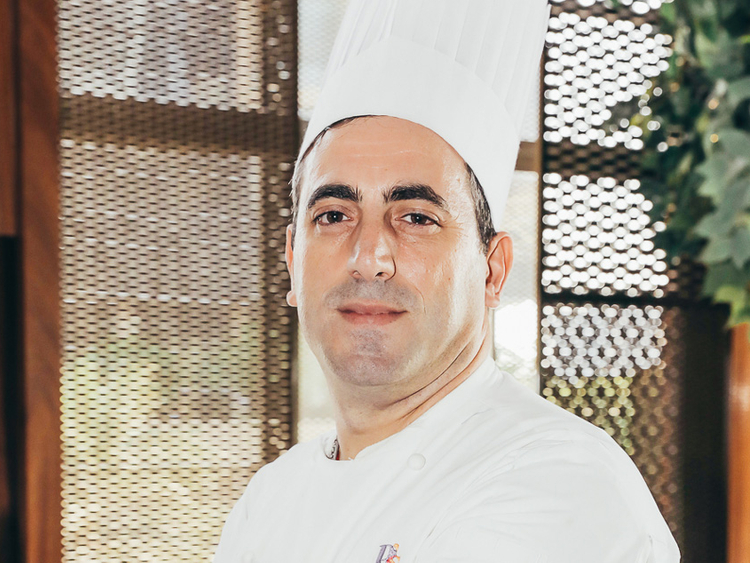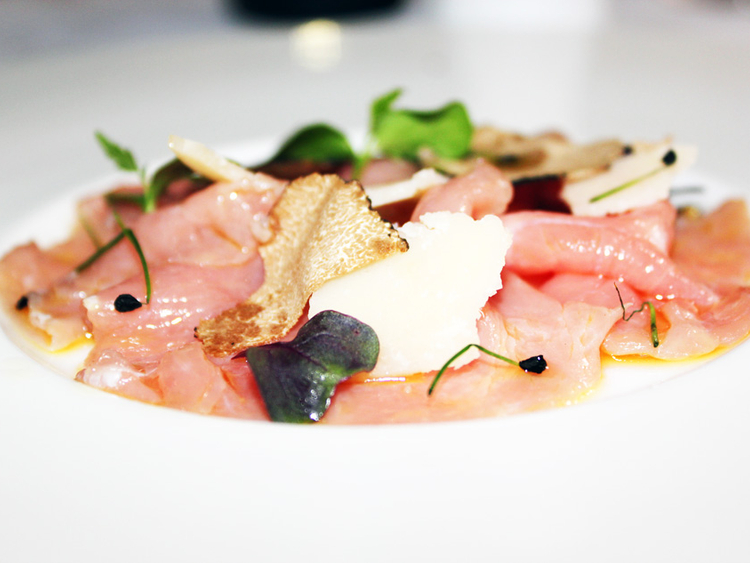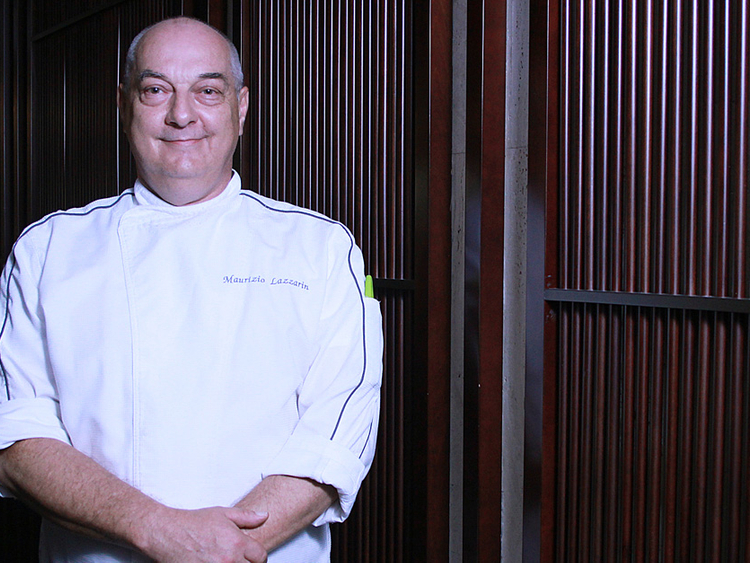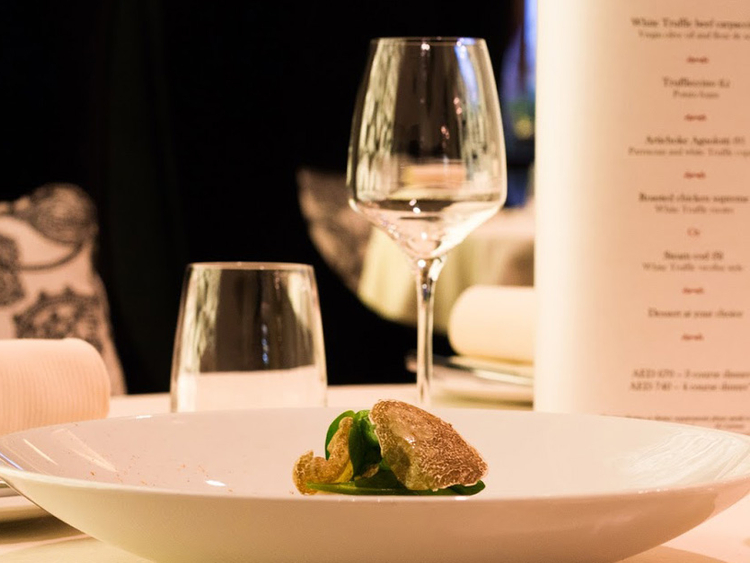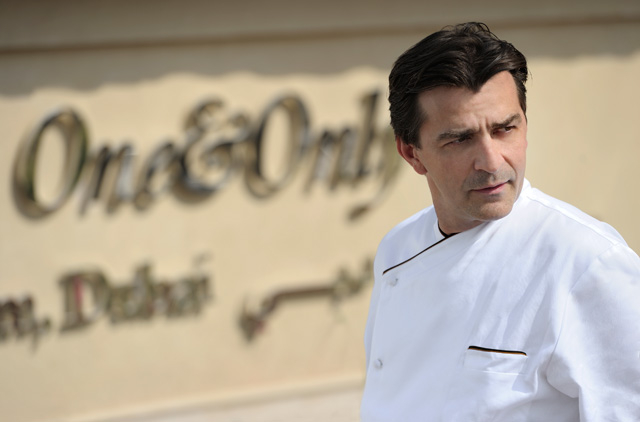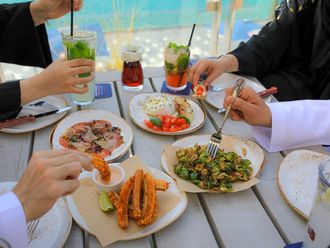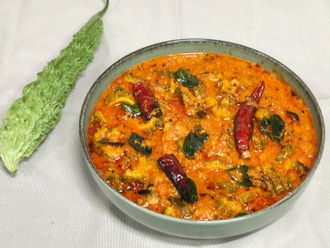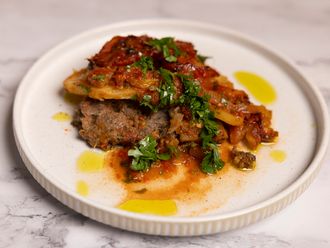
Slowly, lovingly, Massimo Vidoni opens up a Tupperware box and unwraps the tea towel inside. Nestled within, each one wrapped in tissue paper, are what to the untrained eye appear to look like misshapen potatoes. Immediately, a musky, garlicky aroma, likened to everything from love affairs to locker rooms, wafts across the restaurant. I inhale deeply, and the Emirati ladies two tables down pause their conversation and look over. For an instant, their eyes widen, then, with a knowing smile, and they’re back to their burrata.
Across the table, Vidoni is triumphant. Like a proud father displaying his first born, he holds up the first few of these tuberous rocks for me to examine, sniffing each and exclaiming over the smell. Pale cream and surprisingly, they fit snugly in the palm of my hand — I wouldn’t be the first to try and get away with slipping some of this white gold into my pocket.
Over my shoulder, Alessandro Miceli ridicules them, pooh-poohing at their quality and jeering at the size — before breaking out into laughter and agreeing to buy them all.
Vidoni is perhaps the country’s best-known purveyor of white truffles and Miceli is head chef at Roberto’s Dubai, which has acquired a reputation for its inventive recipes using this ingredient favoured by shaikhs and kings.
While their banter may be light-hearted, it belies a more brutal reality: the trade has been likened to underworld smuggling and drug dealing, and not without reason. “I filmed a session of truffle hunting for Italy Unpacked with the BBC in Italy with Carlo Capporici in Piedmont with his beautiful truffle hunting dog, Vigo,” Giorgio Locatelli, whose London restaurant boasts a Michelin star, told Gulf News tabloid! via email. “Sadly he was poisoned by a rival truffle hunter, which really shocked me.”
Thankfully, we’re insulated from those horrors in the comfort of Roberto’s Dubai, although Vidoni admits that the supply side has its challenges, with cash-only sales and few tax invoices. “This trade was mostly built from dealings under the table,” he says frankly. Equally so, substandard and counterfeit products abound, which is why Vidoni, the self-styled Truffle Man of Dubai, personally visits chefs (and customers in Emirates Hills) to deliver his precious cargo.
Growing demand
“Six years ago, when I first came to Dubai, only four or five restaurants were using white truffles — Burj Al Arab, Zuma, a couple of others,” Vidoni tells me. “Now, everyone wants truffles.”
His own operation, with orders largely placed over WhatsApp, has grown from a one-man show to 12 people within the UAE, although he now sells the three main kinds of truffles to China, Saudi Arabia and India, as well as a line of products including truffle pasta, butter and appropriately enough for Dubai, gold-flecked truffle honey.
But it is white truffles that command the most excitement. For someone who’s never been invited to the party, it’s hard to understand their appeal. Diners everywhere — from heads of state to garden-variety hedonistas — turn goo-goo eyed at the mere mention of these deformed, reeking lumps of joy. Such is their appeal that even truffle hunters often won’t part with the best ones, no matter what price they’re offered, and punters will pay handsomely to have them flown across the world. At one time, pigs were to find these mushrooms, which grow wild, attaching themselves to the roots of certain kinds of trees, but the swine usually inhaled them before the hunter could even reach out to gather them up.
Tuber Magnatum Pico, to use the Latin name for the white truffle, is now principally harvested by trained sniffer dogs from among the roots of oak and hazelnut groves between late September and mid-December in the northern Italian regions of Piedmont, Le Marche and Tuscany.
"A good truffle hunting dog requires six months of training, perhaps even more, and are highly prized," says Estelle Michel Vesela, General Manager, La Petite Maison Abu Dhabi. A good dog costs perhaps €7,000, but can pay that back many times over, nosing out up to 120 kilos a year.
Across the UAE
Like restaurants across the UAE, Vesela's new eatery has just launched a truffle menu, sourcing its produce directly from a farm in Alba.
How are they being served? The delicate flavour means white truffles are at their best when gently shaved over pasta or eggs as a finishing ingredient, says Yannick Alleno, of Stay at One&Only The Palm and the eponymous three Michelin-star Alleno Paris, because they need fat to maximise their appeal. In contrast, black truffles must be cooked to extract their best, he tells me.
At Stay, Chef Gautier Gaschi puts white truffles into a potato cappuccino and on a plate of steamed cod. Elsewhere, the Cavalli Club is set to launch a new truffle menu soon, with truffles shaved over risotto, foie gras ganache and taglioni.
At Roberto’s Dubai, Miceli’s own white truffle degustation menu is orchestrated to delight every area of the tongue. He pairs white truffles with pumpkin, beef and even chocolate, although his finest achievement this season is a truffle ice cream that you can order topped with truffle shavings and gold leaf — or just the former.
“During truffle season, we are creating a Chef’s Special Menu specifically inspired by white truffle. Approximately, we are consuming 15 to 20 kilos, but again, we are focused on quality rather than quantity,” says Miceli.
Expect to pay for your pleasure, though: this season, they’re selling at Dh50 per gram, and while city restaurants can charge up to Dh600 for a dish with white truffles, others serve them in the Italian style — by the gram.
Such is the demand that prices have risen to a record €6,000 (Dh25,674) per kilo this year, the Italian farmer’s association Coldiretti says, a sharp increase from €5,000 five years ago and €4,500 in 2007. Truffles typically thrive in the cold and the rain, but both have been in short supply in a year marked by heatwaves and drought, something Vidoni says happens every six or seven years, although volumes have declined dramatically over the years.
“Deforestation and pesticides are two of the major problems,” Locatelli says, adding that development plays its part. “Thirty years ago people weren’t sending truffle to Russia and China.”
Truffle auction
Even greater eye-wateringly high prices are expected on November 12, when the annual World Alba White Truffle Auction comes to the Middle East for the first time in its 18-year history. Dubai will be linked via satellite to Hong Kong and the Grinzane Castle in Alba, Italy, the traditional centre for white truffles, as the largest of these culinary diamonds is sold off to the highest bidder. Five truffles attached to local restaurants will be auctioned locally at the Le Meridien Dubai Hotel, with a final, signature giant to be sold off live from Alba to bidders worldwide.
The winner bidder will enjoy a meal with seven friends cooked and served by top chefs such as Gary Rhodes and Reif Othman.
Total sales of at least half a million euros are expected, with local proceeds going to the Al Jalila Foundation. Last year’s event raised €450,000 for charity, with Chinese chef Zhenxiang Dong paying €100,500 for a 1.17kg specimen. However, frequent buyer Stanley Ho, a Macau billionaire and casino owner, holds the record for the highest-priced white truffle sold at auction, paying $330,000 in 2010.
“We came up with the idea of bringing the World Truffle Auction to this city because we think Dubai would be the right place to break the world record of the most expensive white truffle sold in the history of the Truffle Auction,” says Aira Piva, general manager of Italian Restaurant Consulting, a support organisation for Italian restaurants worldwide. Those attending the dinner also get to try the real deal for themselves, with Locatelli, and Le Meridien Dubai Head Chef Maurizio Lazzarin serving a menu based around the delicacy, including veal carpaccio and beef ribs with truffle polenta. Diners concerned about quality and ethics will be able to rest assured that they’re eating the real deal.
————
How to buy truffles
Three tips to buying white truffles from Le Meridien Dubai Head Chef Maurizio Lazzarin
• Smell: Be sure to get a very distinct aroma from the truffle, it has to smell fresh, if it does not have a pungent smell then it is not fresh.
• Texture: The best truffles are hard which means they are fresh and should be easy to shave. If they are even slightly soft at any place, do not buy them.
• Colour: The perfect colour for white truffle is sandy light brown and not dark brown.
————
3 of the best… kinds of truffles
• Fresh white truffles: Tartufo Bianco or Tuber Magnatum Pico vary in colour from cream to mustard yellow, and in size from 15g to 100g, although rare specimens grow to up to a kilo. When cut in half, white truffles should demonstrate a clear white marbling on a cream or fawn background. Characterised by a complex, garlicky aroma and intense taste that is at its best when shaved onto a creamy, fatty base. They must be consumed within a week of being hunted
• Black winter truffles: Tuber Melanosporum, the second-most commercially valuable species, is named after the Perigord region in France, but are also successfully grown in Australia. Black-brown in colour with small pyramidal cusps, they average about 10cm in width and can be eaten raw or cooked. With an earthy smell that has a hint of cocoa, they have a peppery, nutty flavour that works well with pasta, fish and poultry. When cut, mature black winter truffles are dark with white veins.
• Summer truffles: Found across Europe, but harvested mainly in the summer, particularly in Italy, although a Burgundy variant is best in December, Scrozone or Tuber Aestivum are musky and earthy in flavour and weight between 30g-100g per piece. Ranging from light to dark brown in colour with a bumpy skin, they cut open to reveal marbled cream or pale brown flesh. Better cooked than raw, they pair well with pasta, rice and eggs. Look for hazelnut, chocolate and vanilla notes. They keep for about two weeks after being harvested.



